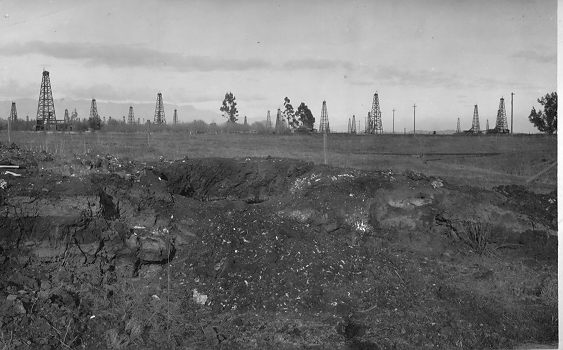2.17.2009
Mammoth Found on Wilshire Boulevard, Crazy Town, Project 23
>


The Salt Creek Oil Fields, 7 miles West of Los Angeles, 1910, near present-day Wilshire Blvd. (image: U.C. Berkeley wesite)
Going down Wilshire Boulevard toward downtown LA you might pass the offices of various record labels, the La Brea Bakery, and the infamous tar pits, where nearly a century ago, a vast trove of fossilized bones encased in asphalt were found.
It's an unusual location because a water seep or spring intersects with a geological incline that underlies a layer of crude oil, which forms a viscous trap of asphalt beneath the surface of the water. As animals came to drink, some were stuck, becoming prey for scavengers in a process that has been going on for 38,000 years.
Scientists will announce tomorrow the discovery of Zed, an almost complete mammoth skeleton found in an ancient riverbed under an old parking lot. Over tens of thousands of years, the oil seeps have changed their location by a few hundred feet. Working quickly to extract the fossils before construction begins on a new parking facility for a neighboring art museum, a total of 23 large boxes were filled with palaeontological material, the source of the name "project 23." When the announcement is made on Wednesday, February 18, it is estimated that the inventory of the associated museum will double, in what is termed a "palaeontolgical Christmas" by researcher Andie Thomer.
One third party scientist hailed the find: "Usually these things are either lost in the mixing or not recovered in the processing of the oily sand and soil they occur in," said paleontologist Jere H. Lipps of the University of California, Berkeley in an email to AP writers.
The tar pits themselves are a rare occurrence on the North American continent. They are also known in Iraq, Iran, and the Caspian sea area, but not necessarily with the palaeontological richness.
As a result of lightning storms, these oil springs would sometimes catch fire and may have served as inspiration for the fire altar in the Zoroastrian religion. Herodotus refers to the following example:
The Fire-fountain of Hit
At the town of Hit or Hid, near Baghdad in Iraq, there were famous and ancient naphtha springs: the ground was yellow limestone covered with a layer of crystalized gypsum, from which issued springs with salt or bitterly sulphurous water; various gases escaped in large bubbles from these springs, and bitumen flowing on the surface of the upwelling resembled dirty scum. Deposits of salt rimmed the springs. The bitumen issued from these springs with a peculiar sound, was scooped up with palm leaves, stored in large pieces, then diluted with lime and exported by boat. Harvesting bitumen was a local business. There were many pitch or bitumen springs in the vicinity, and naphtha springs as well.

Silver coin of Shapur II, Sassanid Shah n-shah, 240 C.E. with fire-altar)
Labels: 23, brea, la, lipps, tarpits, thomer, zed

